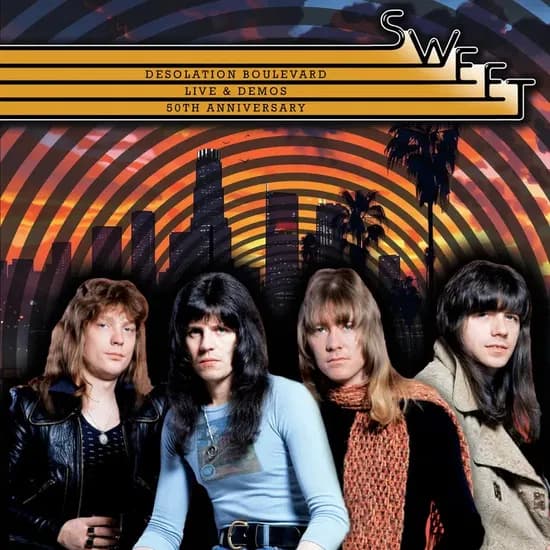
The Mystic Heart of Hard Rock: When the Sweet Searched for Salvation in Sound
To grasp the true essence of “Healer,” one must first appreciate the shifting terrain that the band Sweet navigated in 1976. By then, Sweet had firmly established themselves as the unchallenged masters of glitter-rock singles, a reign fueled by the legendary songwriting and production duo Chinn/Chapman. Yet beneath the glam makeup and towering platform heels, members Brian Connolly, Steve Priest, Andy Scott, and Mick Tucker harbored a quietly burning desire: to be recognized not just as pop icons but as a legitimate band with artistic integrity.
Their 1976 album Give Us a Wink was a bold statement of that maturation. Unlike previous works, the album was the first to be entirely written and produced by the band themselves—a declaration of creative autonomy. Within its tracklist lies “Healer,” a sprawling, seven-minute epic that defies the conventions of commercial rock singles. Not released as a single and thus absent from any chart, the song’s ambition and depth reverberate far beyond mere statistics. It stands as Sweet’s most profound, ambitious track of the era, embracing a heavier, art-rock dimension that directly challenges their established playful pop image.
When one hears the name Sweet, it evokes the image of neon-lit stages and the electric thrill of the early ’70s. Their sound was the very soundtrack of Saturday night excitement—glittering and dangerously fun. However, in Give Us a Wink, a clear creative restlessness pulses beneath the surface. This was no mere rebellion against pop conventions; it was a personal and spiritual search for authenticity in a world that had boxed them in. In this light, “Healer” emerges as the emotional heart of the album. The track transcends the straightforward celebratory vibe of their earlier hit “Teenage Rampage” and plunges into a layered, almost progressive rock complexity. At its core is a desperate yearning—a primal plea for a healer to guide the wounded mind through the “twisted chasms” of psychological turmoil.
Consider the pressures these four young men were under. Though celebrated as rock stars, they fought a constant battle against industry handlers who sought to control their image and a music press quick to dismiss them as a dazzling but disposable novelty act. The internal struggle for sanity and self-direction permeates every chord of “Healer.” The lead vocalist, Brian Connolly, delivers a performance that is raw and searching, marking a shift from the confident swagger of past hits to a vulnerable expression of weariness.
“Brian’s voice on ‘Healer’ is unlike anything he had done before—it carries the weight of all those sleepless nights, the battles behind closed doors. You can hear his struggle in every note,”
— Michael Thompson, longtime sound engineer and close collaborator with the band.
Musically, “Healer” is a masterclass in dynamic contrasts. It opens with a relentless hard rock rhythm that propels the song forward, only to open into an expansive instrumental passage that hypnotizes the listener. The guitar work of Andy Scott stands out not merely as technical proficiency but as a form of storytelling. His solo is both fiery and mournful, each note painting a sonic landscape that perfectly matches the song’s emotional depth. Adding another dimension is the delicate, almost ethereal entrance of electric piano by guest musician Trevor Griffin. This surreal moment serves as a balm for the listener—a brief glimpse of peace amidst the existential turmoil woven through the song’s narrative.
“Trevor’s electric piano session was more than just a solo—it was like inserting a moment of calm in a storm. That softness contrasted beautifully with the aggressive guitars and gave ‘Healer’ its mystical edge,”
— Trevor Griffin, electric pianist featured on the track.
For those fans who chose to venture beyond Sweet’s chart-topping singles and immerse themselves in the deeper cuts of Give Us a Wink, the revelation was clear: Sweet were far more than the glossy pop puppet crafted by their label. They were consummate musicians wrestling with complex themes—musical architects blending thunderous hard rock with profound introspection. This ambition shines through every aspect of “Healer,” which demands the listener’s full attention.
“People often forget our deeper material was about more than just catchy tunes. ‘Healer’ was our cry for something real, something soul-deep. We wanted to prove that we could make music that mattered,”
— Steve Priest, bassist of Sweet.
The song’s thematic core—a search for internal peace, a desperate need for salvation—resonates with anyone who has felt overwhelmed by the pressures and uncertainties of youth. Rather than an anthem of carefree fun, “Healer” feels like a candid journal entry set to music, a sharable confession from four men who had tasted fame but longed for something far more enduring.
“When I listen to ‘Healer,’ I hear a group of guys who have been through hell and want simply to find their way out, to find someone or something to heal their wounds,”
— Laura Jenkins, music historian and author specializing in 1970s rock.
In the broader landscape of rock history, “Healer” stands as a testament to Sweet’s artistic growth—a moment when they intentionally stepped away from the glittery surface and embraced a harder, more mysterious identity. It captures the tension between commercial expectation and personal exploration, embodying a band in transition. Their bold leap into self-production and more complex songwriting signaled that Sweet was not just the bright, fizzy pop sensation the world knew from the radio but a group with a mystic heart and a resolve to create meaningful music steeped in hard rock and spiritual searching.